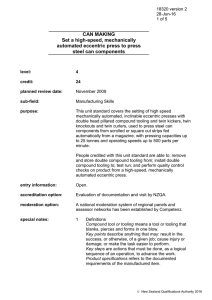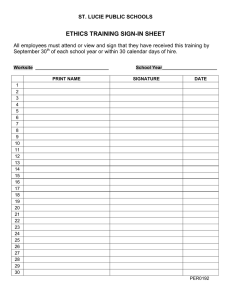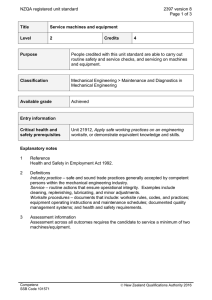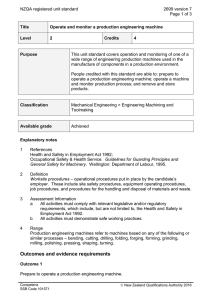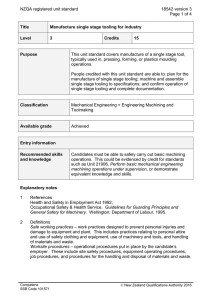CAN MAKING Set a mechanically automated, inclinable eccentric press to press steel
advertisement
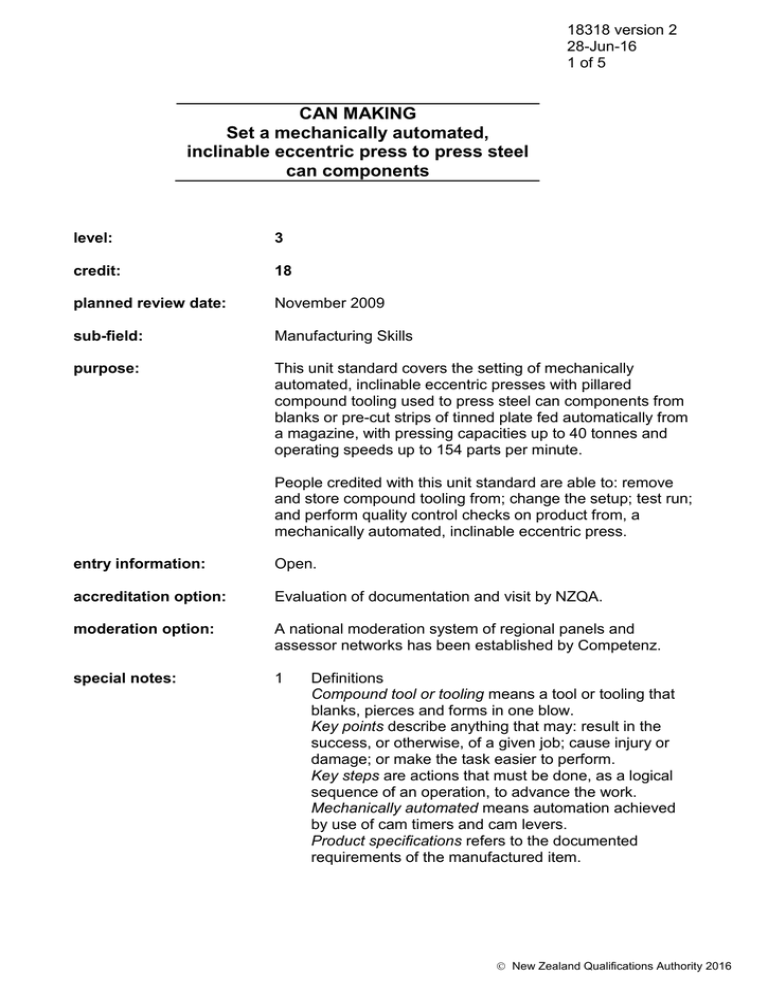
18318 version 2 28-Jun-16 1 of 5 CAN MAKING Set a mechanically automated, inclinable eccentric press to press steel can components level: 3 credit: 18 planned review date: November 2009 sub-field: Manufacturing Skills purpose: This unit standard covers the setting of mechanically automated, inclinable eccentric presses with pillared compound tooling used to press steel can components from blanks or pre-cut strips of tinned plate fed automatically from a magazine, with pressing capacities up to 40 tonnes and operating speeds up to 154 parts per minute. People credited with this unit standard are able to: remove and store compound tooling from; change the setup; test run; and perform quality control checks on product from, a mechanically automated, inclinable eccentric press. entry information: Open. accreditation option: Evaluation of documentation and visit by NZQA. moderation option: A national moderation system of regional panels and assessor networks has been established by Competenz. special notes: 1 Definitions Compound tool or tooling means a tool or tooling that blanks, pierces and forms in one blow. Key points describe anything that may: result in the success, or otherwise, of a given job; cause injury or damage; or make the task easier to perform. Key steps are actions that must be done, as a logical sequence of an operation, to advance the work. Mechanically automated means automation achieved by use of cam timers and cam levers. Product specifications refers to the documented requirements of the manufactured item. New Zealand Qualifications Authority 2016 18318 version 2 28-Jun-16 2 of 5 CAN MAKING Set a mechanically automated, inclinable eccentric press to press steel can components Setup, in the context of this unit standard, is synonymous with the term changeover. Either term may be used in the reading and interpretation of this unit standard. Worksite procedures means all documented operational procedures put in place by the candidate’s employer. These include: site safety procedures; equipment operating procedures; standard job procedures; and procedures for the handling and disposal of materials and waste. 2 All work practices must meet recognised codes of practice and documented worksite safety procedures (where these exceed the code) for personal, product, and worksite safety, and must meet the obligations required under current legislation. 3 Legislation relevant to this unit standard includes but is not limited to the: Health and Safety in Employment Act 1992; Resource Management Act 1991; Hazardous Substances and New Organisms Act 1996. Elements and Performance Criteria element 1 Remove and store compound tooling from a mechanically automated, inclinable eccentric press. performance criteria 1.1 Press is isolated and locked out in accordance with worksite procedures. 1.2 Tools and fittings for compound tool removal are identified and selected in accordance with worksite procedures. 1.3 Compound tooling is removed in accordance with worksite procedures. New Zealand Qualifications Authority 2016 18318 version 2 28-Jun-16 3 of 5 CAN MAKING Set a mechanically automated, inclinable eccentric press to press steel can components 1.4 Compound tooling is cleaned, and damage or wear is identified and actioned in accordance with worksite procedures. Range: damage or wear to include – build-up, blunt cutter, sticking knockout, damaged cutter, chipped cutter, damaged former. 1.5 Compound tooling is stored in accordance with worksite procedures. 1.6 Tool removal documentation is completed accurately and legibly in accordance with worksite procedures. element 2 Change the setup of a mechanically automated, inclinable eccentric press. Range: one of – can end size, install compound tooling. performance criteria 2.1 Potential safety hazards during setup are identified, and isolation and lockout procedures are followed in accordance with worksite procedures. 2.2 Setup components are selected and explained in terms of their purpose and method of operation, and are verified against production requirements. 2.3 Setup is explained in terms of procedural sequence and key points for each key step. Range: key steps to include – machine cleaning, prior adjustments, handling equipment, feed bar positioning, tool centralising, tool weight, main table height, ejector table height, feed bar, dead stop position, gear change, feed magazine, translator arm, knockout ring length, Gregory kicker ejector rollers, double-sheet detector, load guard. 2.4 Press is prepared for setup in accordance with worksite procedures. 2.5 Setup is performed in accordance with worksite procedures. New Zealand Qualifications Authority 2016 18318 version 2 28-Jun-16 4 of 5 CAN MAKING Set a mechanically automated, inclinable eccentric press to press steel can components element 3 Test run a mechanically automated, inclinable eccentric press. performance criteria 3.1 Raw materials, product and press operation are explained in terms of common problems and corrective actions in accordance with worksite procedures. Range: common problems to include – knockout timing, kicker timing, feed finger spacing, incorrect stroke, knockout lengths, blunt cutters. 3.2 Press is test run in accordance with worksite procedures. 3.3 Tooling and press adjustments are made until press operates in accordance with worksite procedures. element 4 Perform quality control checks on product from a mechanically automated, inclinable eccentric press. Range: quality control checks to include – counter-sunk depth, lip height, straightened curl, neck diameter. performance criteria 4.1 Quality control checks are performed and recorded in accordance with worksite procedures. 4.2 Quality control check results are explained in terms of relationships between press and tool settings, product specification tolerances, and variance trends. Comments on this unit standard Please contact Competenz qualifications@competenz.org.nz if you wish to suggest changes to the content of this unit standard. New Zealand Qualifications Authority 2016 18318 version 2 28-Jun-16 5 of 5 CAN MAKING Set a mechanically automated, inclinable eccentric press to press steel can components Please Note Providers must be accredited by the Qualifications Authority or a delegated interinstitutional body before they can register credits from assessment against unit standards or deliver courses of study leading to that assessment. Industry Training Organisations must be accredited by the Qualifications Authority before they can register credits from assessment against unit standards. Accredited providers and Industry Training Organisations assessing against unit standards must engage with the moderation system that applies to those standards. Accreditation requirements and an outline of the moderation system that applies to this standard are outlined in the Accreditation and Moderation Action Plan (AMAP). The AMAP also includes useful information about special requirements for providers wishing to develop education and training programmes, such as minimum qualifications for tutors and assessors, and special resource requirements. This unit standard is covered by AMAP 0013 which can be accessed at http://www.nzqa.govt.nz/site/framework/search.html. New Zealand Qualifications Authority 2016
